Repair Tips Request – Maitland-Smith Table
Greetings! I was wondering if I might be able to solicit some assistance with a recent acquisition. My wife and I bought a Maitland-Smith chess table from an auction. It is in really beautiful shape.
The problem is that the top table wobbles a good bit, an inch or so of give in either direction. I would love to get some suggestions on how to repair it so that the tabletop is perfectly stable.
As you can see from the pictures, the table has a rectangular base that is secured to the top with 6 short screws. That rectangle sits atop the harp curls. The pictures show that there is some slight separation from the top of the harp curls to the underside of the table. My initial thought was that I could remove the 6 screws and take the top of the table off, and possibly apply some wood glue or screws to tighten this rectangular base back down, and then re-attach the table top. The trouble is that once the 6 screws are removed, the table top remains attached. I do not see any signs of wood glue around this base, but it is my suspicion that perhaps the previous owner applied wood glue in an effort to secure it. I am concerned about possibly damaging the table top or rectangular base if I were to try and use a putty knife or such to separate the two, not knowing for certain if they even do separate.
If the table top will not come off, I thought perhaps I could drill some pilot holes just behind the rounded end of the harp curl and maybe use a screw to try and pull the base back down towards the harp top and stabilize it.
Any tips or advice that folks could give to assist me with this table would be greatly appreciated! Please let me know if you need additional information or pictures!
Thank you!
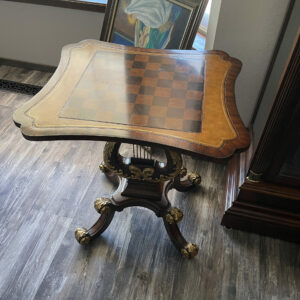
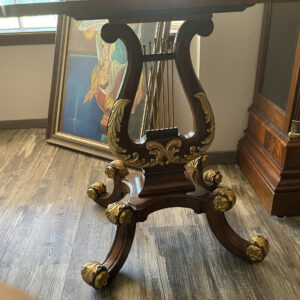
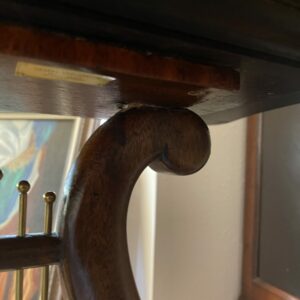
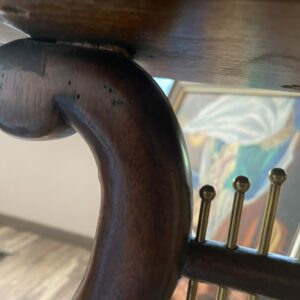
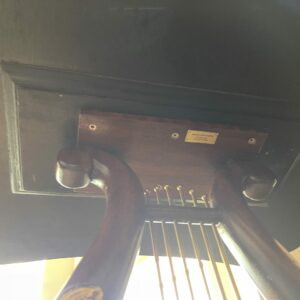














Replies
I think you have a Frankentable. IMO the base and top are from two seperate pieces. The guy that took the time to add that mitered molding around the upper (middle?) layer would not have then screwed the other part to it with no trim (and off-center from the look of it). I suppose it's possible that they refinished the base and not the top, but the added layer still makes no sense.
I don't know your costs, so this advice is worth exactly what you're paying for it... To me it's been apart before and will come apart now. I would not hesitate to go with the putty knife (or several) approach. I would not be surprised to find some double-stick tape in there, along with marks from the original base. No decision on the repair is possible until you can see what you have to work with.
Thank you for this perspective. I did at one point try to separate it with a putty knife but it was hard going, which makes me suspect wood glue was used to bind the top down. Because it was so hard going I stopped fearing I might damage the base. I feel I may give it another try with the putty knife.
It would be most interesting to find out it is a frankentable, an expert on this particular brand would be able to say for certain.
Thank you!
If the movement is in the rectangular base have you considered using a longer screw in place of the shorter ones? If so, how long could you use without going thought the top?
Unfortunately the movement is in the entire table top and rectangular base. The slight wobble seems to becoming from where the rectangular base meets the top of the harp curls. That is what made me think that if I can get the table top off the rectangular base I could reinforce that joint from the top down, or by drilling some pilot holes through the bottom of the harp curls to pull the whole top back together.
Thank you for your thoughts!
I would imagine that screws through the harp would cause it to split...especially if someone leans on the table top.
My two favorite YouTube channels for fixing furniture are Thomas Johnson Antiques and Fixing Furniture. I suggest watching some of these videos and you will have some knowledge on what to do.
I agree that this looks like a Frankentable and I think the wobble in your top is really a design issue and is unlike to be solved with a longer screw. The top is resting on two points at the top of the harp. Both of these are rounded. You have very little structure to stop the rocking motion. A screw may be able to initially provide enough clamping force to reduce to rocking, but unless you add a third point of contact, you will struggle to eliminate it. It is more of a structural design issue and not a construction issue. Essentially you have a two legged table sitting on a four legged base. I wonder if the original piece the base came from had two similar bases supporting a top (this would give 4 points of contact) and maybe one base was destroyed, resulting in this interesting design.
As #7 Jake w stated it is a structural design flaw. I would say franken parts were used. Doing some research on Maitland-Smith it would appear this manufacture maybe doing this sometimes. Manufactures have lots of parts left over in production runs. So why not? Going up through the harp curl with a longer/larger screw may work provided the inside is solid enough to support it. Unfortunately the top really needs four contact points as Jake suggests.